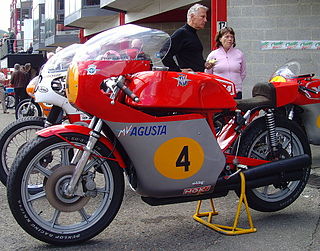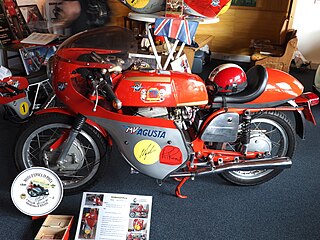
MV Agusta is a high end motorcycle manufacturer founded by Count Domenico Agusta on 19 January 1945 as one of the branches of the Agusta aircraft company near Milan in Cascina Costa, Italy. The abbreviation MV stands for Meccanica (mechanics) Verghera, the hamlet where the first MVs were made. The modern headquarters and main production facilities are located in Varese, Italy on the shore of Lake Varese.

The MV Agusta 500cc Three (1965–1973) or MV Agusta Tre was a road racing motorcycle produced by the Italian manufacturer MV Agusta to compete in the 500 cc Grand Prix motorcycle racing World Championship. The motorcycle was introduced in 1966 to compete against the ever competitive Honda racing machines and was a bored out version of MV Agusta's highly successful 350 cc three cylinder. Giacomo Agostini won consecutive world championships in the 500 cc class with this motorbike from 1966 to 1972. In addition, MV Agusta won the Constructors' World Championships from 1967 to 1972. The MV Agusta Tre is considered the most successful racing motorcycle in history.

The MV Agusta 350B (Bicilindrica) was a series of motorcycles produced by the Italian manufacturer MV Agusta from 1970 to 1974. The motorcycle was first introduced at the Milan motorcycle show in 1969. The introduction of the "350" model was intended to bridge the production gap of MV Agusta in the medium-displacement sector and to take advantage of the prestige gained by the dominant GP racers. It was produced in "Sport", "Gran Turismo" and "Scrambler" versions.

The MV Agusta 750 S also known as the MV Agusta 750 Sport, was a motorcycle manufactured by the MV Agusta company from 1970 to 1975. Production total of this model series was 583 machines.

The MV Agusta 750 Sport America was a motorcycle manufactured by the MV Agusta company from 1975 to 1977. Derivative models were produced in limited numbers until 1982, and the Magni models are still available to special order.

The MV Agusta 600, also called the MV Agusta 600 4C and the MV Agusta 600 Turismo, was a motorcycle built by the MV Agusta company from 1966 to 1970. For the first time, a four-cylinder engine was fitted transversely to the direction of travel on a standard motorbike and cable-operated disc brakes were used. A total of 135 of this model were manufactured.

The MV Agusta 500 four-cylinder (1973–1976) was a racing motorcycle manufactured by the Italian company MV Agusta, for competing in the 500 cc series, the premier class of the FIM World Motorcycle Championship. With this motorcycle MV Agusta won the 1973 constructor's world champion and Phil Read won the 1973 and 1974 500 cc riders world championships.

The MV Agusta 350 6 cilindri was a prototype racing motorcycle built by the Varese company MV Agusta in 1957, for the 350 cc class of the FIM Motorcycle World Championship. The project was resurrected in 1968. Neither version was ever used in a race. The only surviving model is now in the MV Agusta factory museum.

The MV Agusta 250 Bicilindrica was a 250 cc factory racing motorcycle manufactured by the Italian brand MV Agusta from 1957 to 1961. With this machine 11 GPs, 2 Driver Championships and 2 manufacturers World Championships were won.

The MV Agusta 175 were a series of motorcycles produced by the Italian manufacturer MV Agusta from 1953 to 1960. The series included touring, GT, sports and supersports models. There were also two racing variants. Because of the shape of the petrol tank, the sports and supersport models became known as the Disco Volante. The series was MV's best seller.

The MV Agusta 125 Bialbero was a 125 cc factory racer from the Italian brand MV Agusta, which was used between 1950 and 1960. The machine won 34 GPs, 6 rider's championships and one manufacturer's championship. The machine also won 4 Italian Championships and 10 National Championships in other countries.

The MV Agusta 125 Motore Lungo, more commonly known as the "carter lungo", was a 125 cc, lightweight two-stroke motorcycle manufactured between 1950 and 1953 by Italian motorcycle manufacturer MV Agusta. The machine was often used in racing.

The MV Agusta 125 Pullman was a motorcycle produced by the Italian manufacturer MV Agusta from 1953 to 1956. The model achieved a good sales success, and had the highest production of any machine from MV Agusta. Many brought the bike as the only means of family transport or as a work vehicle. Despite the questionable aesthetics, the Pullman offered a comfortable ride, derived by the driving position, soft suspension and large section tires. This was particularly appreciated by users, so much so that they were imitated by some competitors. 27,000 machines of this model series were produced. The model was also produced under licence in Spain by Avello, where it was marketed as the MV Avello 125 Pullman Turismo.

The MV Agusta Turismo Veloce is a motorcycle produced by the Italian motorcycle manufacturer MV Agusta. The machine premiered at the 2013 EICMA, but production was delayed due to the financial crisis being experienced by the manufacturer. The motorcycle was first made available to the press for road tests in April 2015.

The MV Agusta 350 Ipotesi (Hypothesis) was a motorcycle produced by the Italian manufacturer MV Agusta from 1975 to 1977. The machine was conceived by Italian designer Giorgetto Giugiaro and based on the previous 350 B Sport Elettronica model. 1,991 "Sports" and 350 “Turismo” machines were produced.

The MV Agusta 125 Sport SE was a sport motorcycle built from 1975 to 1977 by the Italian manufacturer MV Agusta. It was one of the last models to be produced by Meccanica Verghera at their Cascina Costa plant.

The MV Agusta 150 Sport RS was a motorcycle produced by the Italian motorcycle MV Agusta in their Cascina Costa plant from 1959 to 1969.

The MV Agusta Raid was a series of 250 and 300 cc motorcycles manufactured by the MV Agusta company in Cascina Costa, Italy from 1957 to 1961. At the time of introduction, the 250 cc class was considered a large capacity motorcycle.
The MV Agusta 250B (Bicilindrica) was a motorcycle produced by the Italian manufacturer MV Agusta from 1968 to 1971. The motorcycle was first introduced at the 1965 Milan EICMA motorcycle show and was based on the stillborn MV 166 Arno GT. The model was discontinued in 1971 following the introduction of an overbored version, the 350B.

The Ducati Deluxe is a 247 cc (15.1 cu in) single cylinder bevel drive SOHC motorcycle produced by the Spanish manufacturer MotoTrans, who were licensed by Ducati to produce motorcycles under the Ducati brand name. The model was based on the 'narrow case' Ducati Diana 250 and produced from 1963 to 1973. The Deluxe was, in terms of production numbers, MotoTrans' most successful model.



















